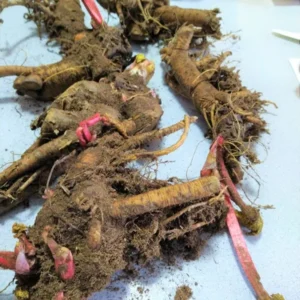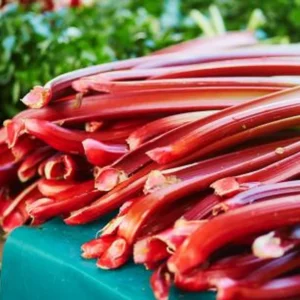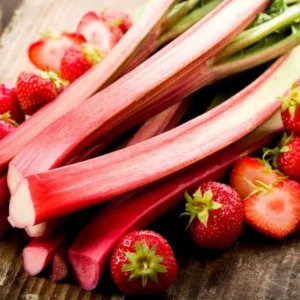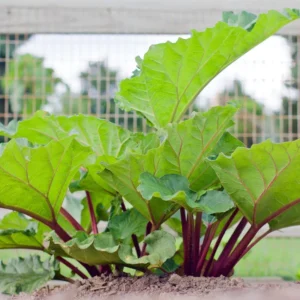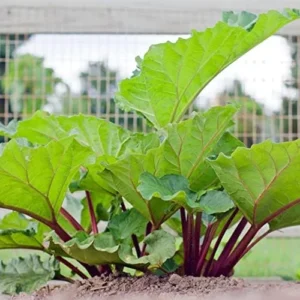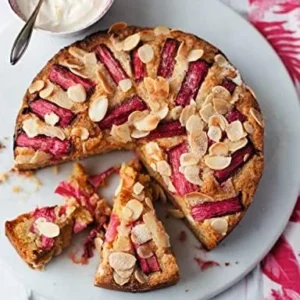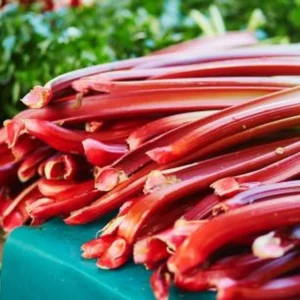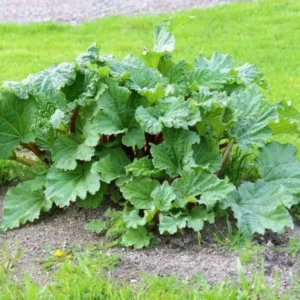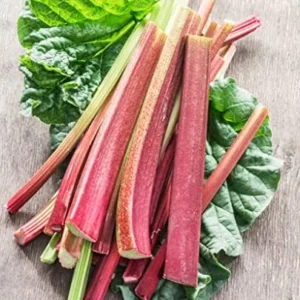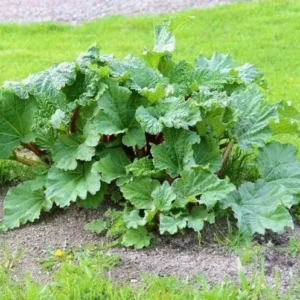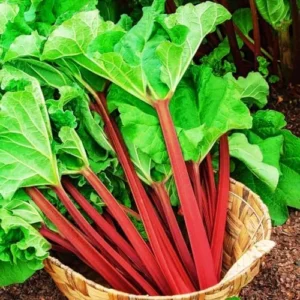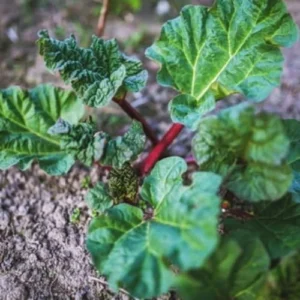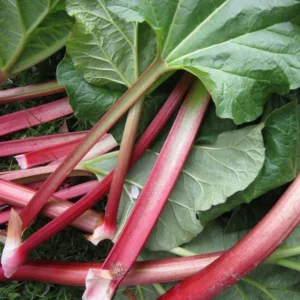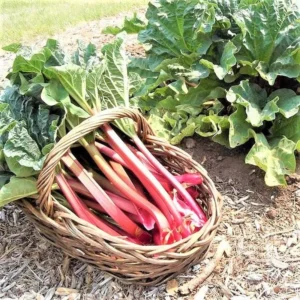Have you ever spotted those gorgeous ruby-red rhubarb stalks at a farmers’ market and thought, “I wish I could grow that in my garden”?
Or maybe you’ve tried rhubarb-strawberry pie at a summer picnic and wondered how to bring that tart, old-fashioned flavor into your own kitchen.
The truth is, red rhubarb (Rheum × hybridum) is one of the most forgiving perennial vegetables you can grow. Once you give it the right spot in your garden, it will keep coming back year after year—stronger, redder, and tastier.
In this guide, I’ll share everything I’ve learned about planting, caring for, and harvesting red rhubarb plants. Whether you’re a beginner gardener or a seasoned pro, you’ll walk away with the confidence to grow rhubarb that makes your neighbors jealous and your pies unforgettable.
What Is Red Rhubarb?
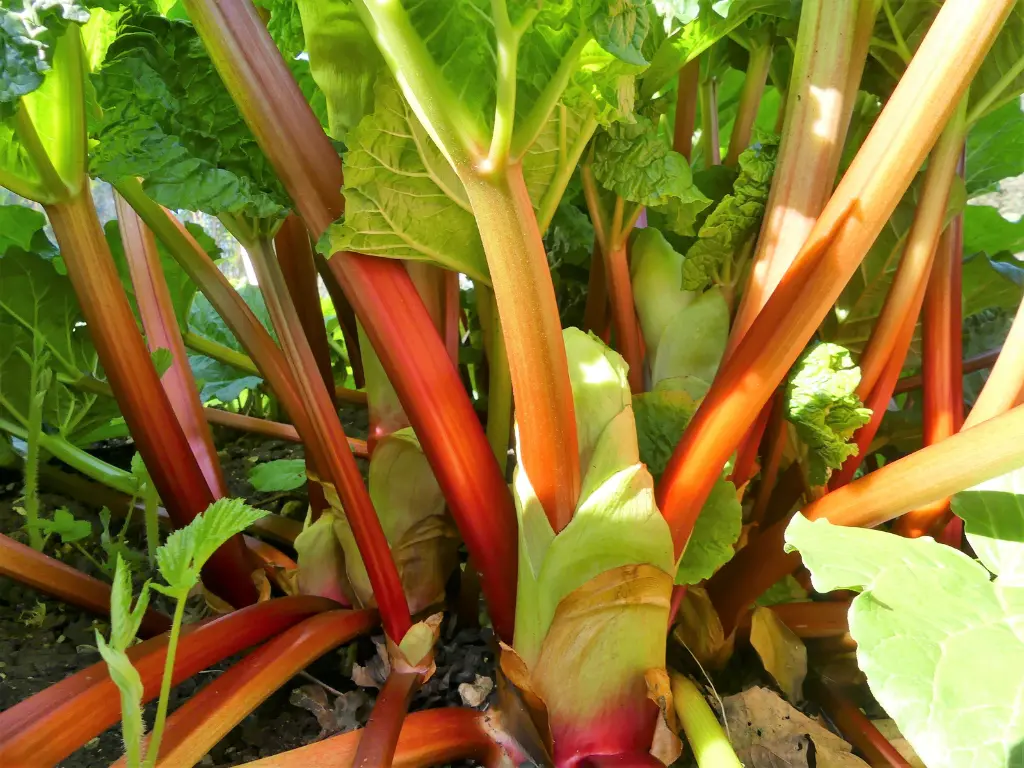
Red rhubarb is often called the “pie plant,” and for good reason. Its stalks are tart, colorful, and a perfect partner to sweet fruits like strawberries. Unlike green rhubarb, which can look a little plain in the kitchen, red varieties are prized for their vivid stalks that add a pop of color to desserts.
Keep in mind, though, that only the stalks are edible. The leaves contain oxalic acid and should always be discarded. That said, don’t let the toxicity scare you off—it’s easy to separate the leaves when harvesting, and gardeners have been enjoying rhubarb safely for centuries.
Benefits of Growing Red Rhubarb
Culinary Uses
Red rhubarb is more versatile than you might think. Yes, pies and crumbles are classics, but here are some other fun ways to use your harvest:
-
Stir chopped rhubarb into oatmeal for a tangy kick.
-
Make rhubarb chutney to serve with grilled chicken or pork.
-
Simmer a quick rhubarb sauce for pancakes or waffles.
-
Blend rhubarb with strawberries and mint for a refreshing summer drink.
Once you start experimenting, you’ll realize that rhubarb is just as at home in savory dishes as it is in sweets.
Garden Benefits
Red rhubarb isn’t just about taste—it’s also a gardener’s dream.
-
It’s a perennial: plant once, and you’ll be harvesting for up to a decade.
-
It adds ornamental beauty: the bold stalks and large leaves make a striking statement in the garden.
-
It’s low-maintenance: with the right soil and some occasional TLC, rhubarb practically takes care of itself.
Ideal Growing Conditions for Red Rhubarb
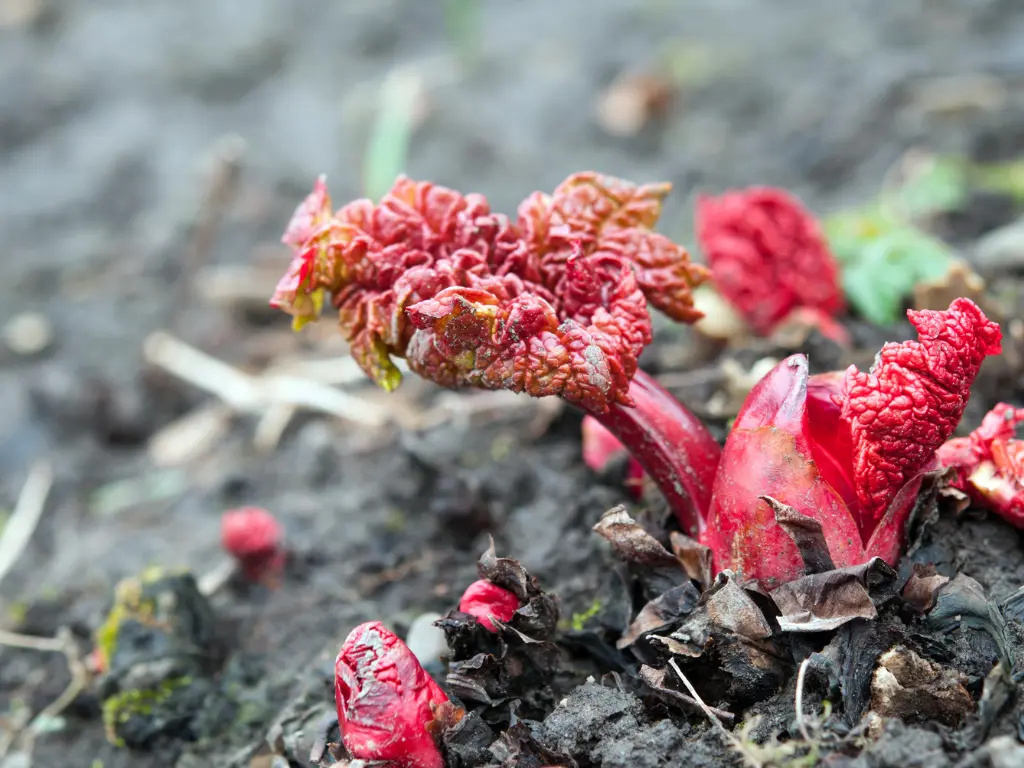
Sunlight Requirements
Rhubarb loves sunlight. Aim for at least 6 hours of direct sun each day. In the northern U.S., full sun is perfect. In hotter southern states, afternoon shade helps keep stalks from wilting.
A gardener friend of mine in Texas grows rhubarb under a light shade cloth during July—and swears it’s the only way to keep the stalks bright and firm.
Temperature and Hardiness Zones
Rhubarb is happiest in cooler climates, thriving in USDA zones 3–7. It needs a cold winter rest to perform well the following spring. If you’re in a warmer region, you can still try heat-tolerant varieties, but you’ll need to mulch heavily and provide shade.
Soil Preferences
Good soil makes all the difference. Here’s what rhubarb craves:
-
Rich, loamy soil with lots of compost or aged manure.
-
A pH between 6.0 and 6.8.
-
Excellent drainage to prevent root or crown rot.
If your soil is heavy clay, don’t worry, just build a raised bed or add sand and organic matter to improve drainage.
Read more:
- Top 10 Best Plants That Improve Soil Quality, Making Your Whole Garden Thrive
- How to Prepare Soil to Plant: A Step-by-Step Guide for Beginners
Care Tips for Red Rhubarb
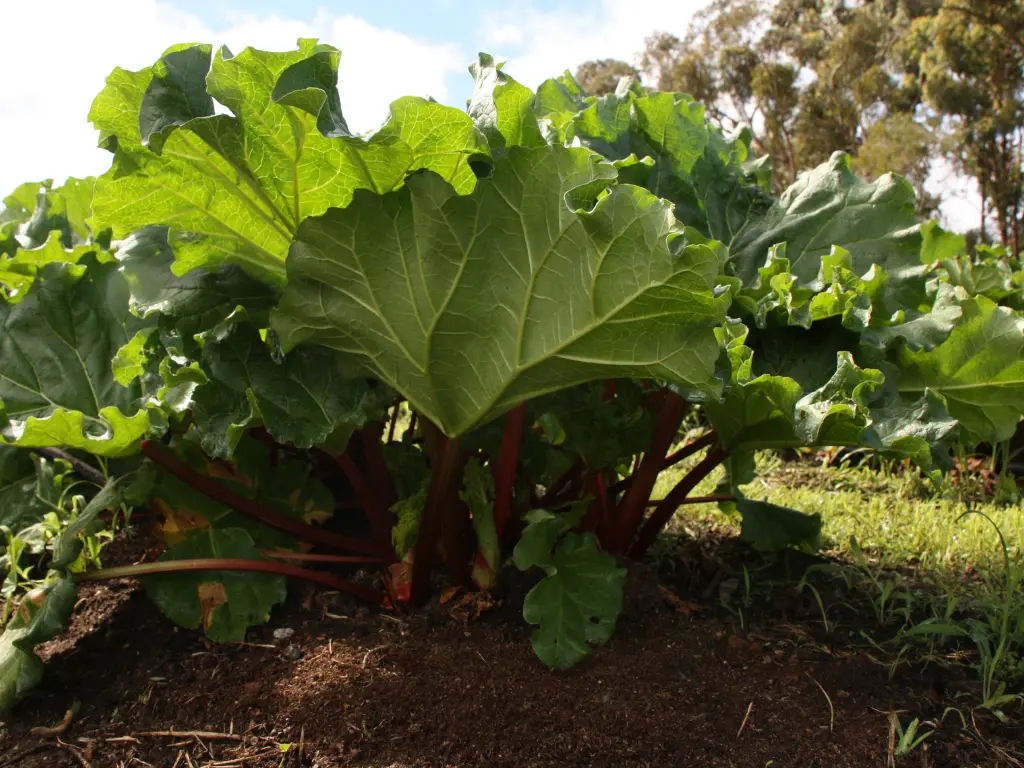
Watering
Think of rhubarb as a thirsty friend. It doesn’t want soggy feet, but it does want steady hydration.
-
In spring and summer, water once or twice a week, depending on rainfall.
-
Mulch with straw or shredded leaves to lock in moisture.
-
If stalks are limp, that’s a clear sign your rhubarb needs a drink.
Fertilizing
Feed your rhubarb early in the spring, just as new growth begins.
-
Compost or well-rotted manure is best.
-
A balanced fertilizer (10-10-10) works well if you prefer something store-bought.
-
Don’t overdo it—too much nitrogen makes lush leaves but skinny stalks.
Mulching and Dividing
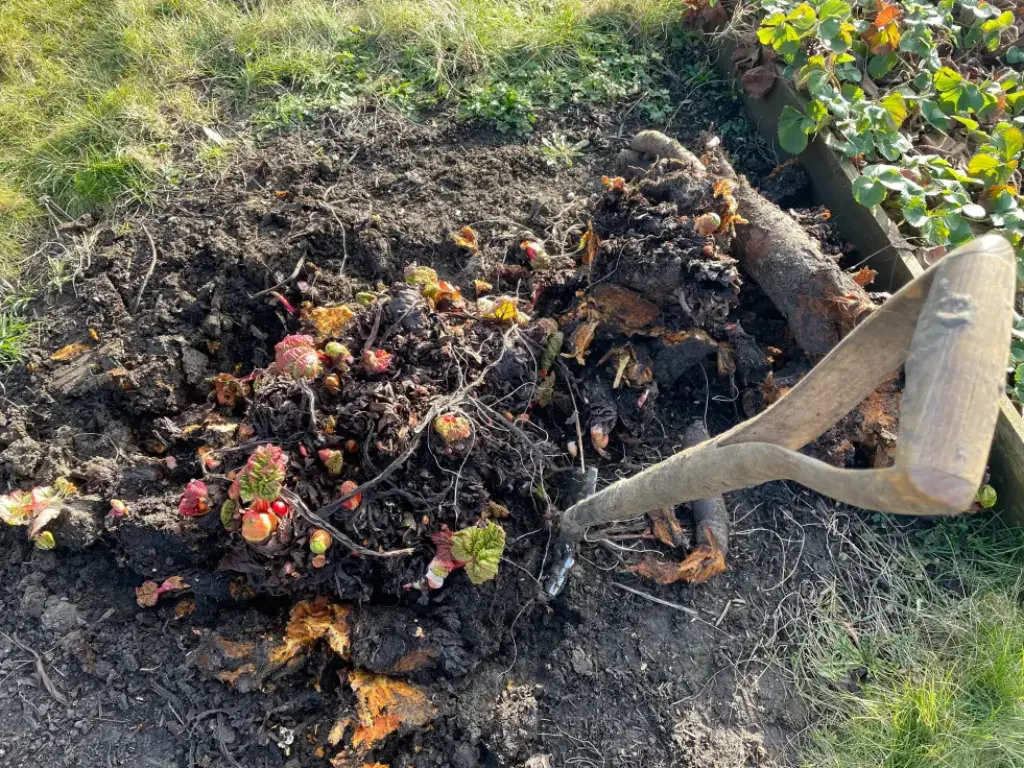
Mulching is one of the easiest ways to keep your rhubarb patch healthy. A thick layer of straw, shredded leaves, or compost in spring helps retain soil moisture, regulate temperature, and suppress weeds around the crowns. In colder climates, a winter mulch also protects roots from freezing.
But beyond mulching, dividing your rhubarb plants every 4–5 years is key to keeping them vigorous and productive. Over time, a mature crown can become crowded, leading to thinner stalks and slower growth.
When to Divide Rhubarb
-
The best time is in early spring, just as the soil warms up and before tender new shoots start to emerge.
-
You can also divide in early fall if needed, but spring is ideal for giving new divisions a full growing season to establish.
How to Divide Rhubarb
-
Use a sharp spade or garden fork to dig around the root clump, about 6 inches (15 cm) deep, and carefully lift the whole plant out of the ground.
-
With a clean, sharp knife or spade, cut the crown into sections. Each section should contain at least one healthy bud (two or three buds are even better) and plenty of attached roots.
-
Replant each division in well-prepared soil, spacing them about 3 feet apart to give room for growth.
-
Water thoroughly and mulch around the base to lock in moisture.
Pro tip: Don’t worry if dividing feels intimidating; splitting rhubarb isn’t rocket science. As long as each piece has a bud and roots, it will grow into a healthy new plant.
Read more: How And When To Split Rhubarb Plants
Seasonal Care Tips for Red Rhubarb
-
Spring: Water regularly, feed with compost, start harvesting.
-
Summer: Keep watering steady, mulch to hold moisture, harvest lightly in hotter weather.
-
Fall: Stop harvesting, cut back dead foliage, and add compost around the crown.
-
Winter: Let the plant rest. In colder zones, mulch heavily for protection.
Frost Damage
If red rhubarb gets hit by a late spring frost, you can still eat the stalks as long as they are firm and upright. Frost injury usually shows up as brown or black edges on the leaves. However, if the stalks become soft or mushy, don’t eat them. Severe cold can push oxalic acid from the leaves into the stalks, raising the risk of poisoning. When in doubt, cut off the damaged stalks, compost them, and let new healthy stalks grow for harvest.
Pest and Disease Control
Rhubarb doesn’t attract many pests, but you may occasionally see:
-
Slugs munching on young leaves.
-
Aphids clustering on stems.
-
Crown rot if soil stays too wet.
Most issues can be solved with good drainage, organic slug traps, and a quick rinse of leaves with insecticidal soap.
Common Problems and How to Fix Them
-
Yellowing leaves: Usually overwatering. Check drainage.
-
Thin stalks: Too much shade or poor soil. Move to a sunnier spot or enrich the soil.
-
Flowering stalks (bolting): Cut them off quickly to redirect energy into edible stalks.
Harvesting Red Rhubarb Safely
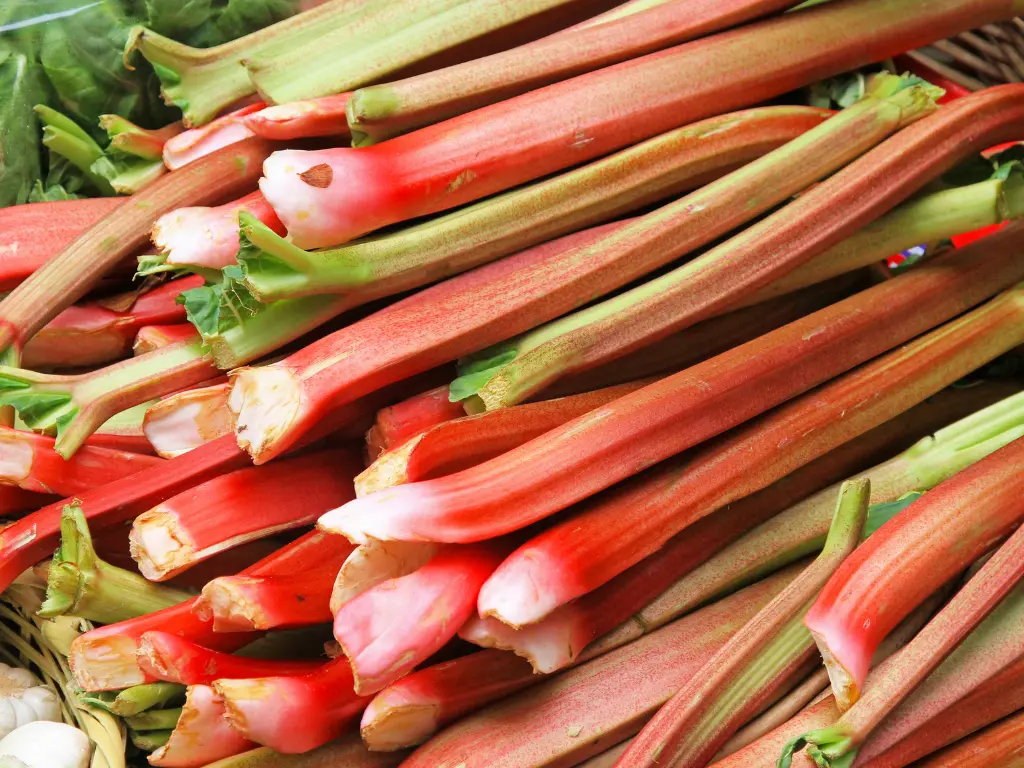
Patience is key when it comes to rhubarb. Don’t harvest in the first year—this allows the plant to build strong roots. In the second year, take only a few stalks. By the third year, you can harvest more freely, usually from late April through June, depending on your region.
How much to harvest:
-
Never remove more than one-third to one-half of the stalks at one time.
-
Stop harvesting once stalks become slender, which signals that the plant’s reserves are low.
-
Allow enough foliage to remain so the crown can stay healthy.
Best harvesting method:
-
Grasp each stalk near the base and pull it gently to one side with a twist.
-
Avoid cutting stalks with a knife, as cuts can open wounds for crown rot.
Storage tips:
-
Fresh rhubarb keeps for 2–4 weeks in the fridge at high humidity.
-
Store stalks in perforated plastic bags in the crisper drawer.
-
For longer storage, chop and freeze rhubarb pieces.
End-of-season care:
-
After the final harvest in early July, let plants grow until frost kills the tops.
-
Once the ground freezes, cover crowns with 2–3 inches of straw mulch to reduce crown rot risk.
-
In spring, remove mulch from the crowns but leave some around plants to help with weed control.
Pro tip: The earlier in the season you harvest, the sweeter and juicier the stalks will be. Late-season rhubarb is often more tart. Rhubarb leaves can safely go into the compost pile. The oxalic acid they contain breaks down quickly and won’t harm compost quality.
Propagating Red Rhubarb
The easiest way to expand your rhubarb patch—or share with a neighbor—is by dividing crowns.
-
In early spring, dig up a mature plant.
-
Use a sharp spade to slice the crown into sections, each with at least one bud and some roots.
-
Replant sections 3 feet apart, water well, and mulch.
Within weeks, you’ll see fresh growth emerging.
Frequently Asked Questions (FAQs)
1. Can I grow red rhubarb in hot climates?
Yes, but it will need partial shade and lots of mulch to keep roots cool. Consider planting in raised beds for better drainage.
2. Why aren’t my rhubarb stalks turning red?
Some varieties naturally have greener stalks, even if they’re healthy. Cooler weather often enhances red color, while heat can fade it.
3. Is rhubarb safe for pets?
The stalks are fine for humans, but rhubarb leaves are toxic for pets and livestock. Always discard them safely.
4. How long does a rhubarb plant last?
With good care and occasional division, a rhubarb plant can produce for 8–10 years or more.
Conclusion
If you’ve been dreaming of growing a plant that delivers beauty in the garden and flavor in the kitchen, red rhubarb is your answer.
It’s hardy, forgiving, and practically begs to be turned into pies, jams, and sauces. With just a little planning—good soil, consistent water, and some seasonal TLC—you’ll enjoy years of colorful, tart harvests.
So go ahead, give red rhubarb a sunny spot in your garden, and let this perennial beauty reward you season after season. And when you pull that first batch of crimson stalks, don’t forget to treat yourself to a homemade pie. You’ve earned it.
You may like:

